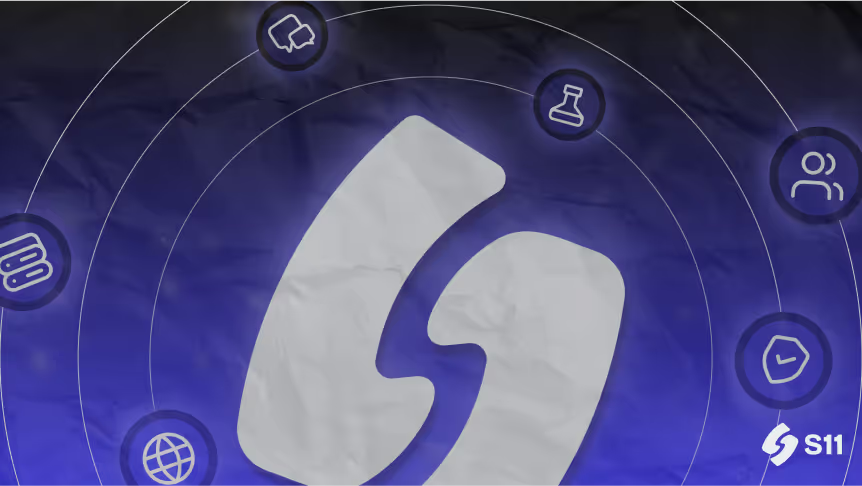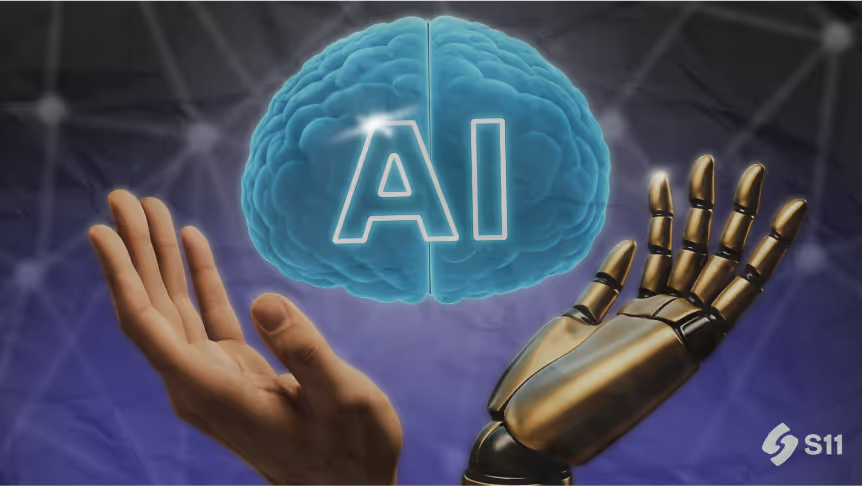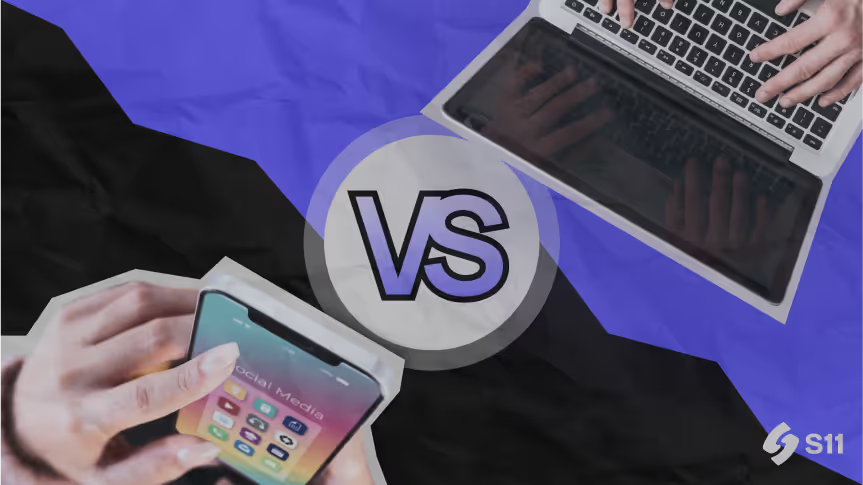How to Digitally Modernise Without Disrupting What Works
Digital Transformation
Business Strategy
June 23, 2025
Written by: Kurt C.

1. Introduction: Defining Non-Disruptive Digital Modernisation
1.1. Digital Modernisation vs. Digital Transformation: A Crucial Distinction
Digital modernisation strategically integrates advanced technologies into existing systems to boost efficiency, agility, and competitiveness. It's a hybrid approach, leveraging current investments while gradually transitioning to more innovative solutions. Digital transformation, conversely, is a broader overhaul, entailing fundamental changes to business processes, models, and culture to adapt to the digital age. Non-disruptive modernisation is a specific path within this, updating systems without interrupting daily operations, akin to adding a "modern translator" to legacy systems. This approach is chosen for its low risk and commitment to business continuity.
1.2. The Imperative for Non-Disruptive Approaches
Modernising complex legacy systems is often compared to "performing surgery on a living organism, delicate, high-risk, and prone to complications". Organisations, especially those with complex operations, require a cautious approach to change. Digital modernisation optimises existing processes while rigorously maintaining stability. For sectors demanding continuous availability (e.g., healthcare, finance), a gradual approach is often the only viable option, ensuring critical operations remain functional and mitigating the apprehension of disrupted business continuity. This strategy prevents systemic shock and preserves competitive advantage through secure, continuous evolution.
2. Why Gradual Modernisation? Benefits Over "Big Bang" Approaches
2.1. Reduced Risk and Minimal Downtime
Incremental modernisation significantly lowers disruption risk by implementing changes progressively. By upgrading specific components, the "blast radius" of potential failures is limited, allowing for real-time adjustments and localised disruptions. This iterative testing ensures issues are addressed before they escalate, maintaining critical operations with minimal to no downtime.
2.2. Cost Efficiency and Increased Flexibility
Small, manageable updates are less costly than comprehensive overhauls, allowing investments to be distributed over time and reducing financial risk. Organisations implementing comprehensive modernisation often report 30-50% reductions in application maintenance and operational costs, plus 15-35% infrastructure savings annually. This financial flexibility enhances organisational agility, allowing dynamic reallocation of funds and transforming IT into a strategic enabler.
2.3. Improved Efficiency and Enhanced Security
Modernising specific processes improves efficiency through automation, eliminating redundant systems and optimising workflows. AI-powered automation streamlines tasks, reduces human error, and optimises resource allocation. Upgrading legacy systems also enhances data security, safeguarding sensitive information from cyber threats. Modern security frameworks lead to faster threat identification, quicker patching, and rapid threat containment. Modernisation also helps meet regulatory compliance (e.g., GDPR).

3. Core Principles and Strategic Roadmap for Non-Disruptive Modernisation
3.1. Thorough Assessment and Planning
The modernisation journey begins with a comprehensive assessment of existing legacy systems to identify strengths, weaknesses, and pain points. This includes understanding architecture, technology stack, functionality, and integration points, ideally with multiple domain experts. Clear business and technical goals must be defined, aligning modernisation efforts with overarching business objectives like improving efficiency, scalability, or user experience.
3.2. Develop a Phased Roadmap and Prioritise Incremental Changes
A structured, phased approach is crucial, involving a detailed roadmap with timelines, resources, and risk identification for each phase. The strategy emphasises starting small and iterating, prioritising less critical systems or components first to test new technologies and gather feedback in a controlled environment. This iterative process reduces overall risk and localises disruptions.
3.3. Embrace Agile Methodologies and Continuous Value Delivery
Leveraging agile methodologies is critical, breaking down projects into manageable iterations ("sprints") that deliver shippable product increments. This enables rapid progress and adaptability. Agile fosters continuous improvement through frequent stakeholder feedback, ensuring alignment with changing business needs and faster time-to-market. Continuous Delivery practices ensure software remains deployable throughout its lifecycle, aligning with Agile's principle of "early and continuous delivery of valuable software".
3.4. Change Management and Stakeholder Engagement
Organisational culture significantly impacts readiness for change. Resistance often stems from fear of the unknown or lack of understanding. Proactive change management strategies are essential, including cross-functional teams, clear communication, and targeted support programs. Involving stakeholders and providing comprehensive training helps build momentum and reduces resistance, ensuring successful adoption.
4. Architectural Patterns for Incremental Updates
4.1. The Strangler Fig Pattern
The Strangler Fig Pattern incrementally migrates a legacy system by gradually replacing functionalities with new services. It uses a routing layer (e.g., API gateway) to direct traffic between old and new components, minimising disruption. The process involves introducing a façade, incrementally shifting requests, decommissioning the legacy system, and finally removing the façade. This pattern is ideal for large, complex monolithic applications, ensuring business continuity, minimising risks, and enabling continuous delivery.
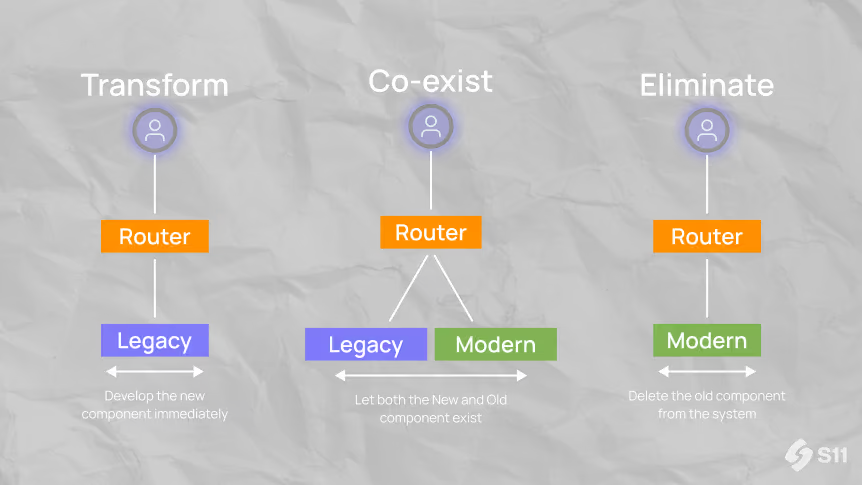
4.2. The Anti-Corruption Layer (ACL) Pattern
An Anti-Corruption Layer (ACL) preserves data and model integrity during integration with external or legacy systems. It acts as a mediation layer, translating data and requests between disparate systems to prevent "corrupt" data from impacting the core system. ACLs perform data translation, request translation, and data validation. This pattern is useful when monolithic applications communicate with new microservices with differing domain models, offering a quick way to adapt systems with minimal impact and reduced transformation risk.
4.3. Branch by Abstraction
Branch by Abstraction (BBA) enables gradual, large-scale changes to a software system while allowing continuous releases. It isolates significant code changes through an abstraction layer, crucial for trunk-based development and CI/CD pipelines. The process involves identifying the target, creating an abstraction layer, gradually migrating client code, building a new supplier, and then gradually swapping out and deleting the old components. BBA decouples release schedules, reduces merge conflicts, and allows safe testing in production using feature flags.
4.4. Incremental Microservices Adoption
Incremental microservices adoption involves iteratively re-architecting software assets by introducing microservices piecemeal, guided by business value. This transition typically involves identifying strategic goals, defining architectural changes, advancing resource readiness (e.g., reorganising teams), and changing critical development practices (e.g., supporting hybrid architectures). Best practices include gradual introduction (often using Strangler Fig), database decoupling, consistent API gateways, robust testing, and embracing DevOps practices. This approach integrates architectural patterns, technical practices, and organisational change to achieve agile, scalable architecture without "rip and replace."
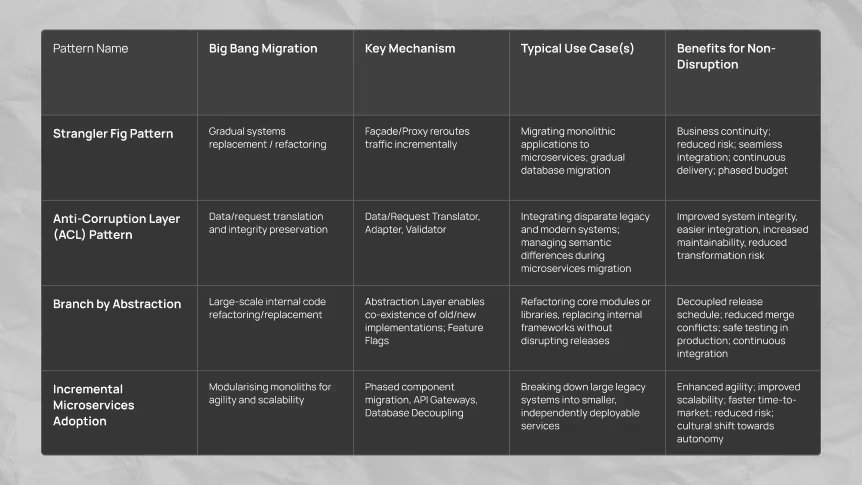
5. Enabling Technologies for Seamless Modernisation
5.1. Cloud Computing
Cloud computing is foundational for non-disruptive modernisation, offering scalability and flexibility. Cloud platforms enable rapid, cost-effective application deployment, dynamic resource scaling, and reduced operational costs and downtime. Its elasticity and pay-as-you-go model support incremental changes, providing a resilient, high-availability environment crucial for business continuity.
5.2. Containerization and Orchestration (Docker, Kubernetes)
Containerization (e.g., Docker) enhances scalability and flexibility by isolating workloads, making updates faster and less risky. Containers ensure consistent application performance across environments, simplifying deployment. Orchestration platforms (e.g., Kubernetes) automate container deployment, scaling, and management, improving fault tolerance, resource utilisation, and reliability. These technologies are essential for operationalising incremental modernisation, providing isolation and portability for deploying new components alongside existing ones.
5.3. API Management and Microservices
Application Programming Interfaces (APIs) are indispensable for communication between legacy and modern systems, bridging the transition. Effective API lifecycle management balances performance, security, and usability, with versioning allowing new features without disrupting existing users. API management tools centralise control, securing connections, tracking usage, and alerting teams to problems. Robust integration solutions simplify legacy integration by enabling modern API creation without extensive custom coding.
5.4. AI-Powered Automation and No-Code/Low-Code Platforms
AI-powered automation systems significantly accelerate efficiency by streamlining repetitive tasks, improving operational efficiency, and reducing human error. No-code and low-code platforms democratize innovation, empowering users to build custom applications without traditional coding, accelerating development, reducing IT reliance, and lowering costs. These technologies act as force multipliers, automating modernisation and empowering business users, fostering continuous, decentralised innovation.
5.5. DevOps Tools and CI/CD Pipelines
DevOps software and Continuous Integration/Continuous Deployment (CI/CD) pipelines form the operational backbone of continuous modernisation, automating build, test, and deployment processes. This automation reduces errors, accelerates delivery, and enhances reliability. Infrastructure as Code (IaC) tools (e.g., Terraform, Pulumi) bring consistency and automation to infrastructure. Robust continuous monitoring and observability tools (e.g., Prometheus, Grafana) provide real-time visibility for proactive issue detection. These tools facilitate the mechanics of non-disruptive change, enabling frequent, small releases.
6. Critical Considerations for a Smooth Transition
6.1. Managing Technical Debt
Technical debt, stemming from outdated practices, complicates future updates, making changes slow and expensive. It can manifest as security gaps and lead to system instability. Organisations must adopt an "intentional" approach, balancing debt reduction with business outcomes. Refactoring is key to improving maintainability and reducing future debt. Managing technical debt incrementally prevents future disruption and ensures long-term sustainability.
6.2. Ensuring Data Integrity and Security During Migration
Data loss, corruption, and security vulnerabilities are common risks during migration. Threats can arise from low-quality data, human error, transfer errors, and malicious actors. A robust data migration strategy is essential, encompassing data audit and cleansing, defining data quality metrics and validation, and implementing secure protocols (e.g., encryption, MFA). Continuous data quality checks and security testing are crucial for a successful, non-disruptive modernisation.
6.3. Addressing Integration Challenges and Dependencies
Legacy systems often pose significant integration challenges due to outdated technologies, a lack of documentation, and tightly coupled architectures. Robust integration solutions are essential, including middleware and API-driven architectures to bridge old and new systems. A thorough assessment of dependencies and rigorous testing (functional, performance, penetration) are critical to manage integration risks and ensure a smooth, non-disruptive transition.
6.4. Continuous Monitoring and Optimisation
Digital modernisation is an ongoing journey, requiring continuous monitoring and optimisation for long-term success. Implementing robust monitoring tools (e.g., APM systems) tracks new system performance in real-time, identifying bottlenecks and inefficiencies. Continuously tracking key performance metrics and gathering user feedback is vital for iterative refinement. Regular updates and security patches maintain system resilience, and exploring emerging technologies ensures future relevance.
Conclusions
Non-disruptive digital modernisation is a strategic imperative for organisations to evolve without jeopardising core operations. This approach offers substantial advantages over "big bang" overhauls by mitigating risk, ensuring business continuity, and fostering continuous improvement.
Success hinges on a multi-faceted strategy: careful planning, iterative implementation, and a human-centric approach. Architectural patterns like Strangler Fig, Anti-Corruption Layer, and Branch by Abstraction provide blueprints for managing complexity and enabling gradual transitions. These patterns facilitate controlled replacement, seamless integration, and large-scale code refactoring while maintaining stability.
Modern technologies—including cloud computing, containerization, robust API management, AI-powered automation, no-code/low-code platforms, and comprehensive DevOps tools with CI/CD pipelines—provide the essential infrastructure for agile, incremental updates. These technologies accelerate modernisation and enhance scalability, security, and efficiency.
Challenges remain, requiring proactive management of technical debt, rigorous attention to data integrity and security, and strategic solutions for integrating legacy components. Crucially, successful modernisation demands an organisational and cultural shift, addressing resistance through clear communication, stakeholder involvement, and continuous training.
Ultimately, non-disruptive digital modernisation transforms technology into a dynamic, continuously evolving capability. By embracing this phased, strategic approach, organisations can achieve significant technological advancement, unlock new business value, and maintain a competitive edge, all without disrupting the very operations that sustain them.

